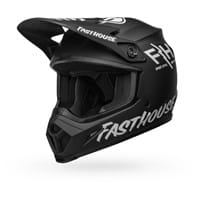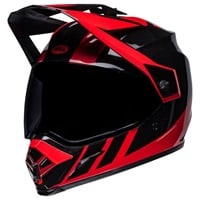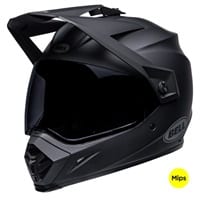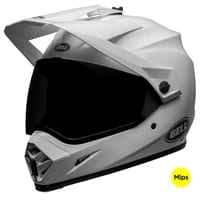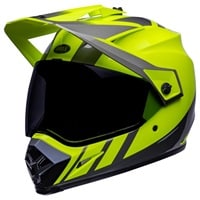As a seasoned rider who’s tested numerous helmets across varying terrains, I’ve found the MX-9 Adventure MIPS offers a compelling mix of features that deserve closer examination.
Its adaptability shines through its ability to transform from a street-focused lid to an off-road-ready piece of gear, making it particularly interesting for riders who blur the lines between pavement and dirt.
But what really sets this helmet apart isn’t just its versatility – it’s the intersection of advanced safety features, comfort, and value.
With a price point that won’t break the bank and technology that could help protect your brain, does the Bell MX-9 ADV MIPS deliver on its promises of being the ultimate dual-sport helmet for both weekend warriors and serious adventure riders?
In this MX-9 Adventure MIPS review, we will examine all its features to determine whether it is the right ADV helmet for you. We’ll assess its comfort, ventilation, and safety features to see how it compares to other adventure helmets on the market. Additionally, we’ll discuss how it stacks up against competitors like the Arai XD5 Dual Sport Helmet in terms of design and performance. By the end of this review, you’ll have a clear understanding of whether the MX-9 Adventure MIPS is the best choice for your riding needs.
Bell MX-9 Mips
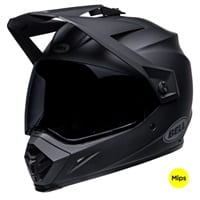
Key Takeaways
- Excellent ventilation works in heat
- Wind noise requires highway earplugs
- MIPS technology protects against brain injury
Our MX-9 ADV MIPS Final Verdict
After testing the Bell MX-9 Adventure MIPS extensively across varied terrain, I’m convinced it offers exceptional value for dual-sport riders.
The helmet combines MIPS safety technology with versatile features at a price point that won’t break the bank.
I particularly like how it handles off-road sections while remaining comfortable enough for street riding.
In my experience, the ventilation system works remarkably well in hot weather, though this comes with some trade-offs.
The helmet’s multiple shell sizes ensure a proper fit across the size range, and the interior padding, while not premium, provides decent comfort for day-long adventures.
I really like the wide eye port that accommodates most goggles, and the face shield’s anti-fog coating helps maintain visibility in challenging conditions.
The MIPS technology gives me added confidence, knowing there’s extra protection against rotational forces during impacts.
Potential Drawbacks to Consider
After using this helmet for several months, I’ve noticed some limitations.
The wind noise becomes significant at highway speeds, requiring earplugs for longer rides. The always-open vents create issues in cold or wet weather, and the peak visor can catch wind above 65 mph.
I’ve also found the interior padding could be plusher for extended wear.
Before you buy elsewhere, check out Revzilla.com for the latest prices on the Bell MX-9 Adventure MIPS.
They often run special offers that can save you significant money, and their price match guarantee ensures you’ll get the best deal available.
If you found this review helpful, please like and share it – it helps Google know you value the content and helps other riders find this information.
Comparison to Similar Models
| Feature | Nexx X.WED3 | Shoei Hornet X2 | Klim Krios Pro |
|---|---|---|---|
| Shell Construction | X-Matrix2 composite shell | Multi-Ply Matrix AIM+ composite | Carbon fiber with Koroyd protection |
| Weight | 3.5 lbs | 4.0 lbs | 3.25 lbs |
| Safety Certifications | ECE 22.06 | DOT and Snell M2020 | ECE 22.06 and DOT |
| Ventilation | 11 adjustable vents with winter insert | CNS-2 system with multiple vents | Three intake, four exhaust ports |
| Special Features | Fast Release System, integrated bluetooth compatibility | Emergency Quick Release System, Pinlock included | Transitions photochromic shield, Fidlock magnetic closure |
| Interior Comfort | X-MART DRY fabric, multiple pad thickness options | 3D Max-Dry II moisture-wicking | Klimatek antimicrobial moisture-wicking liner |
The Nexx X.WED3 stands out with its extensive ventilation system and integrated bluetooth compatibility. The Shoei Hornet X2 offers dual safety certifications and an emergency release system. The Klim Krios Pro impresses with its ultralight carbon fiber construction and innovative Transitions shield.
In terms of ventilation, the Nexx X. WED3 leads with 11 adjustable vents, while the Klim Krios Pro and Shoei Hornet X2 offer fewer but still effective systems. The Shoei is the heaviest at 4. 0 lbs, with the Klim being the lightest at just 3. 25 lbs. This weight difference makes the Klim Krios Pro a great option for riders who prioritize reduced fatigue on long journeys. Additionally, many ‘Klim Krios Pro review‘ articles highlight its carbon fiber construction, which contributes to both its lightweight feel and impressive durability. Despite having fewer vents than the Nexx X. WED3, the Klim still provides adequate airflow for most riding conditions.
For safety, the Shoei Hornet X2 boasts both DOT and Snell certifications, while the others meet ECE and/or DOT standards. Each helmet offers unique comfort features, with moisture-wicking liners being a common thread across all models.
Shell Construction Delivers Advanced Protection
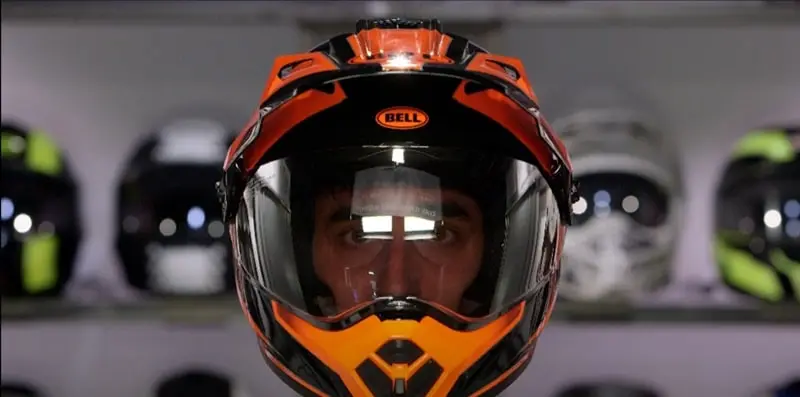
The MX-9 uses a polycarbonate shell integrating MIPS technology for enhanced protection against rotational forces. I’ve found this construction offers solid protection while maintaining reasonable weight for all-day comfort.
The MIPS system allows small rotational movements during impact, reducing forces transferred to your head. A US neuroscientist confirmed this technology’s potential benefits for rider safety.
This multi-shell approach prevents the oversized appearance common in single-shell designs while maintaining proper safety zones for each size range.
Material Performance Trade-offs
| Material Type | Benefits | Limitations |
|---|---|---|
| Polycarbonate | Affordable, Durable | Heavier, More wind noise |
| Fiberglass | Lighter, Better air-flow | Higher cost |
| Carbon Fiber | Lightest, Premium feel | Most expensive |
I found that the polycarbonate construction creates more wind noise than premium materials. However, this trade-off allows Bell to offer advanced MIPS protection at a mid-range price point.
It performs exceptionally well in hot weather but shows limitations in cold and wet weather. I’ve noticed the aggressive styling and ample air flow make it louder than street-focused motorcycle helmets, though earplugs effectively address this issue.
A correctly fitted lid dramatically increases survival chances in crashes. I’ve found the Bell MX-9 requires precise sizing for optimal safety and comfort.
Proper Sizing Determines Safety Performance
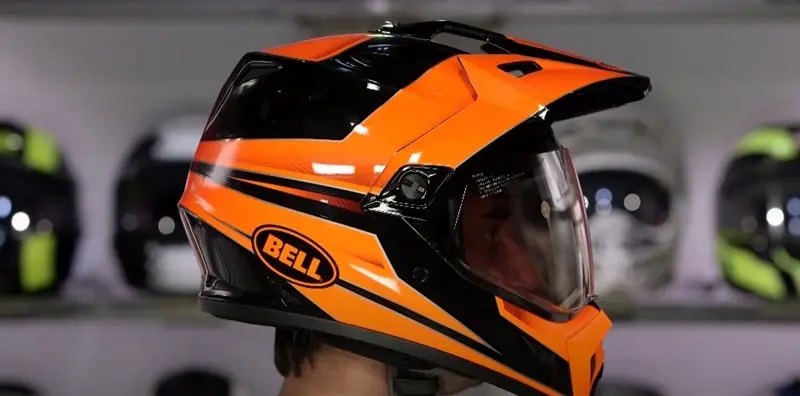
Your helmet should press firmly against your cheeks – tight enough that you can feel the padding but without causing pain. The pressure needs to be even across your head without creating sharp pressure points.
Initial Break-in Period
The interior padding will conform to your head shape over time. Some riders report needing 2-3 rides for the padding to settle.
However, if you experience headaches after 15-20 minutes of wear, that indicates an incorrect fit rather than a normal break-in.
Size Chart and Measurement
| Size | Head (cm) | Head (inches) |
|---|---|---|
| XS | 53-54 | 21¼ – 21⅝ |
| S | 55-56 | 21⅝ – 22 |
| M | 57-58 | 22½ – 22¾ |
| L | 59-60 | 22⅞ – 23¼ |
| XL | 61-62 | 23⅝ – 24 |
| 2XL | 63-64 | 24½ – 24¾ |
Fit Testing Guidelines
To test the fit:
- It shouldn’t move when you shake your head
- Try rotating side-to-side – your cheeks should move with the helmet
- The chin strap should allow two fingers between the strap and jaw
- Someone shouldn’t be able to roll the helmet off your head from behind
The MX-9’s intermediate oval shape works best for most head shapes. If you feel excessive pressure at any point, try the next size up or consider a different model.
Color Options Expand Rider Choice
The MX-9 ADV MIPS comes in an extensive range of colors and graphics to match different riding styles and preferences.
Standard MIPS Model Variety
The standard version offers multiple color schemes:
- Hi-Viz Yellow/Grey
- Dash Black/Red
- Matte Black
- Alpine Series (White/Black, Black/Orange, Chrome/Silver, Grey/Blue)
I’ve found the “dash matt sand-brown-grey” particularly striking on the trails, with its subtle yet distinctive appearance.
DLX MIPS Premium Options
The DLX version comes with:
- Matte Black base color
- ProTint photochromatic shield included ($150 value)
- Marauder Matte/Gloss Blackout special edition
Graphic Design Collections
It features several graphic series:
- Alpine collection with contrasting color schemes
- Marauder series with matte/gloss combinations
- Dash designs with bold color accents
The finish quality stands out across all color options. Each design incorporates reflective elements that increase visibility while maintaining its aggressive styling. The matte finishes have proven particularly resistant to scratches and wear during my off-road testing.
Prices vary by design:
- Solid colors start at $193
- Special editions like the Marauder reach $221
- All versions include MIPS technology regardless of color choice
Interior Comfort Features Matter
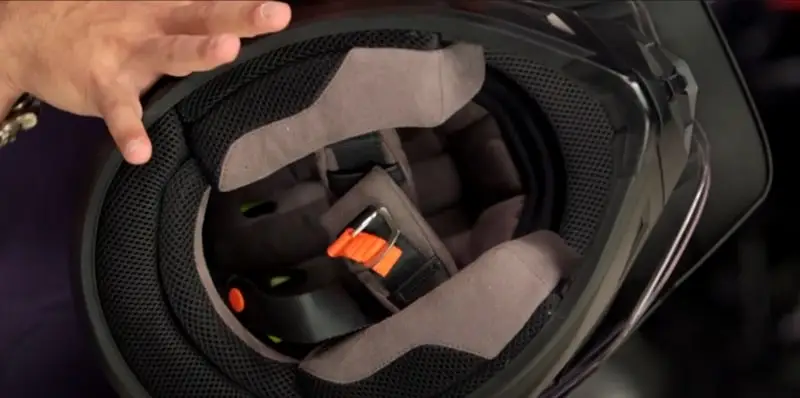
The interior uses a microsuede liner with antimicrobial properties for long-lasting freshness. I’ve found the padding feels plush but isn’t the softest in its class.
Liner Delivers Practicality
The removable liner offers several benefits:
- Quick removal for washing
- Anti-bacterial treatment fights odors
- Moisture-wicking properties keep you dry
While short rides are comfortable, I prefer more padding for all-day comfort.
Cheek Pad Customization
This model has adjustable cheek pads in four sizes (30mm-45mm). This customization helps achieve a proper fit that is crucial for safety. The pads are:
- Removable for cleaning
- Anti-odor treated
- Available in multiple thicknesses
Communication Integration
The EPS liner includes recessed speaker pockets for easy Blurtooth installation. My testing shows:
- Sena installs easily with adhesive strips
- Speakers fit without pressure points
- Good sound quality, even with earplugs
Eyewear Considerations
It lacks dedicated eyeglass channels, presenting challenges. However:
- Standard sunglasses fit adequately
- Shield opens to the first notch for ventilation without vision interference
- Large eye port accommodates most eyewear
The interior design prioritizes air flow and moisture management over plush comfort. While not the most luxurious, it provides good functionality for its price point.
Weight Impacts The Riding Experience
It weighs 3.74 lbs (1698g) in size medium, placing it in the heavier range of ADV motorcycle helmets. I’ve found this weight noticeable on longer rides, particularly with the peak installed.
Weight Distribution Analysis
The lid mass concentrates higher due to the peak and dual-sport design. This creates more fatigue during:
- Head checks at highway speeds
- Off-road technical sections
- Multi-hour touring sessions
Market Comparison
| Model | Weight (lbs) | Material |
|---|---|---|
| LS2 Explorer Carbon | 3.04 | Carbon Fiber |
| Klim Krios Pro | 3.40 | Carbon Fiber |
| Scorpion XT9000 | 3.48 | 3K Carbon |
| Shoei Hornet X2 | 3.66 | Multi-Composite |
| Bell MX-9 ADV | 3.74 | Polycarbonate |
Real-World Performance
The weight becomes most apparent in three scenarios:
- During long highway stretches
- When performing frequent head checks
- In technical off-road sections requiring quick head movements
The polycarbonate construction adds bulk compared to premium carbon fiber alternatives. However, this trade-off enables Bell to offer MIPS technology at a lower price point than lightweight competitors.
Safety Features Protect Riders

The MX-9 Adventure meets both DOT and ECE 22.05 safety standards, incorporating advanced brain protection technology. This dual certification provides confidence for both street and off-road riding.
MIPS Technology Reduces Injury Risk
The Multi-directional Impact Protection works by:
- Creating a low-friction layer between the shell and liner
- Allowing it to slide during angled impacts
- Redirecting harmful rotational forces away from the brain
This technology comes from medical research between a brain surgeon and biomechanics scientist and is specifically designed to reduce brain trauma in accidents.
Competition-Ready Protection
It carries ACU Gold approval, making it legal for:
- Road racing events
- Sprint competitions
- Hill climbs
- Speed events on metalled surfaces
This certification requires passing stringent testing beyond standard road-use requirements.
Bell’s Safety Heritage
Bell’s testing record shows mixed but generally positive results:
- Recent polycarbonate lids score 3 out of 5 SHARP stars
- Historical performance ranks among the safest brands
- Fibreglass models achieve 3-5 SHARP stars
The MX-9 uses three sizes to optimize safety across the size range. This multi-shell approach improves both safety and fit compared to single-shell designs.
Safety Testing Results
Recent SHARP testing in March 2024 evaluated:
- 32 impact tests
- Seven lids across multiple sizes
- Impact protection at five locations
- Linear impacts against flat anvils
The double D-ring fastener provides reliable retention, requiring proper adjustment each time you put it on.
Ventilation Delivers Abundant Airflow

The MX-9 Velocity-Flow ventilation provides exceptional cooling through multiple intake and exhaust vents. I’ve found it works remarkably well in hot weather but can be overwhelming in cold weather.
Strategic Vent Placement
It features seven total vents:
- One large adjustable chin vent
- Two fixed forehead vents
- Two fixed jaw vents
- Four rear exhaust ports
The extended chin bar channels significant airflow past your face, making this setup particularly effective for summer riding and off-road adventures.
Summer Performance Excels
It proves most effective in warm weather. The chin vent delivers generous amounts of air through large channels in the liner, while the rear exhaust vents create consistent airflow. This configuration keeps riders cool even during strenuous off-road sections.
Cold Weather Limitations
The always-open vents create some notable drawbacks:
- Only the chin vent can be closed
- Cold air constantly flows through top vents
- Rain can enter through permanent openings
- Higher wind noise at highway speeds
Real-World Testing Results
During my testing, it performed differently across different weather conditions:
- Hot weather: Excellent cooling and moisture control
- Rain: Water ingress through always-open vents
- Cold weather: Excessive airflow causes discomfort
- Highway speeds: Increased wind noise requires earplugs
The aggressive ventilation makes this lid ideal for summer trail riding but less suitable for year-round touring or wet conditions.
The Visor Mechanism Shows Mixed Performance
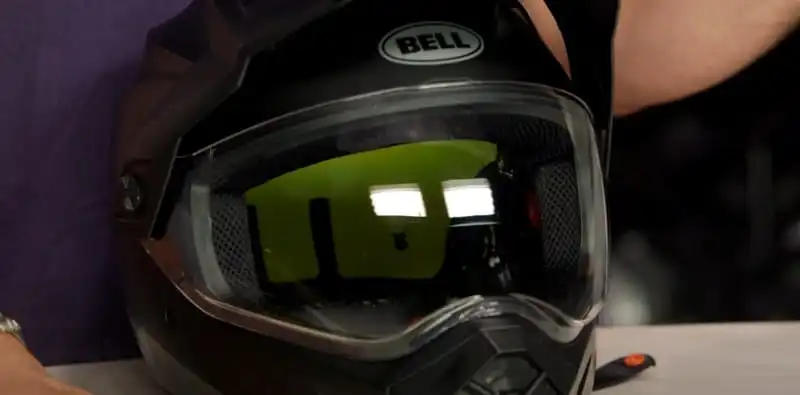
The Bell MX-9 face shield uses NutraFog II anti-fog coating with mixed results. I’ve found the vast visor provides excellent visibility but struggles with fog management in cold and wet weather.
Anti-Fog Technology Falls Short
The NutraFog II coating creates some notable issues:
- Water vapor beads on the inside surface
- Vision becomes fuzzy around lights
- Clarity deteriorates in cold weather
- Forces visor opening on wet rides
ProTint Shield Adds Versatility
The optional ProTint photochromic shield ($150) offers significant benefits:
- Automatically adjusts to light
- Works with goggles without removal
- Comes standard on DLX model
- Installs in minutes with basic tools
Goggle Integration Works Well
It accommodates goggles effectively:
- Shield flips up for goggle use
- Enough room for most goggle brands
- Can close visor over goggles
- No stock goggle strap clip included
Shield Operation Features
The visor includes practical elements:
- Center-mounted tabs for ambidextrous operation
- Stays in position when partially opened
- Forms tight seal against water ingress
- Quick removal visor for cleaning
The vast eye port enhances visibility, but the lack of effective anti-fog treatment remains a significant drawback for cold or wet weather riding.
For year-round use, riders should consider upgrading to the ProTint shield or using goggles in challenging weather.
Noise Levels Demand Attention
The MX-9 generates significant wind noise, reaching up to 115 dB at highway speeds. I’ve found this noise level typical for ADV motorcycle helmets due to their peak visors and increased air-flow.
Wind Speed Affects Sound Generation
The noise levels increase with speed and head position:
- Peak visor creates turbulence
- Always-open vents allow wind penetration
- Large eye port contributes to noise
- Chin curtain gaps permit air infiltration
Noise Reduction Solutions
A properly fitted lid creates a tight seal around the ears and neck, reducing wind noise. I’ve tested several noise reduction methods:
| Method | Effectiveness | Ease of Use |
|---|---|---|
| Bandana | Moderate | Simple |
| Chin Curtain | Good | Permanent |
| Earplugs | Excellent | Required |
Simple Modifications Work
The noise level can be reduced through basic adjustments:
- Tightening the neck roll padding reduces under-helmet turbulence
- Adding foam padding near ear areas improves sound isolation
- Removing the peak visor significantly decreases wind noise
- Using a neck gaiter helps seal the bottom
Professional Solutions Required
For serious noise reduction, consider:
- High-quality motorcycle earplugs
- Improved neck seal installation
- Aerodynamic modifications to reduce turbulence
- Regular inspection of visor seals
The noise levels make hearing protection essential for long rides or highway speeds. Wind noise at 115 dB exceeds safe exposure limits and can cause hearing damage without proper protection.
Bluetooth Integration Enhances Connectivity
The MX-9 features dedicated speaker pockets and cable routing channels that accommodate most modern Bluetooth units. I found it is particularly compatible with both Sena and Cardo.
Communication Options
It works exceptionally well with:
- Cardo Packtalk Edge with JBL speakers
- Sena SMH10R
- Multiple Bluetooth brands using adhesive or clip mounts
Installation Process Simplifies
The installation process takes about 20 minutes. Here’s my tested method:
- Remove cheek pads and liner
- Install speakers in dedicated pockets
- Route microphone through chin area
- Mount control unit on left side
- Connect all cables
- Reinstall padding
Performance Features Stand Out
The design offers several communication benefits:
- Recessed speaker pockets prevent pressure points
- Multiple mounting options for microphone placement
- Easy access to controls while riding
- Clear sound quality with proper speaker positioning
The Cardo Packtalk Edge proves particularly effective, offering excellent sound clarity through its 40mm JBL speakers. It connects to smartphones in under 10 seconds and maintains reliable connectivity throughout rides.
For optimal performance, experiment with speaker placement – even small adjustments can significantly improve sound quality. The design allows for quick removal and reinstallation of communication systems when needed.
Pros & Cons
| Pros | Cons |
|---|---|
| MIPS safety technology included | Noisy at highway speeds |
| Multiple shell sizes for better fit | Limited anti-fog performance |
| Excellent ventilation in hot weather | Always-open vents can’t be closed |
| Good speaker pocket placement | Water ingress through permanent vents |
| Removable, washable liner | Heavier than premium helmets |
| Compatible with most comms units | Peak visor creates turbulence |
| Large eye port for goggles | Can feel bulky compared to street helmets |
| Affordable price point | Interior padding could be plusher |
| ECE and DOT-certified | Wind noise requires earplugs |
| ProTint shield option available | Cheek pads may need size adjustment |
It balances budget-friendly features with solid safety credentials, though it makes some compromises in refinement and weather protection compared to more expensive options.
FAQ
Is the Bell MX-9 MIPS good for long-distance touring?
The MX-9 works well for touring but has limitations. I’ve found it was comfortable for 4-5 hour stretches, though the wind noise becomes noticeable above 65 mph. It keeps you cool but can’t be closed in cold weather. For serious touring, you’ll want earplugs and possibly a neck gaiter for better comfort.
How does the sizing run compared to other motorcycle helmets
It runs true to size in my experience. The intermediate oval shape fits most head shapes well. The multiple sizes (XS-SM, MD-LG, XL-2XL) help maintain proper proportions across the size range. The cheek pads break in after about 15-20 hours of riding.
Can I wear glasses with this helmet?
Yes, but there’s no dedicated eyeglass channel. It accommodates most prescription glasses and sunglasses, though you might need to put them on before the helmet. The large eye port helps with glasses fitment, and the face shield can be cracked open to the first position for additional air-flow without disturbing eyewear.
How effective is MIPS?
MIPS provides additional protection against rotational forces during impacts. The low-friction layer allows 10-15mm of movement in any direction during a crash, potentially reducing brain injury risk. While direct impact testing remains similar to non-MIPS helmets, the rotational protection offers an extra safety margin.
What’s the best Bluetooth unit to use?
Both Sena and Cardo works well with this lid. The speaker pockets accommodate most 40mm drivers, and the design allows clean cable routing. I’ve found the Cardo PackTalk Edge particularly effective, with clear sound quality even at highway speeds.
How does it handle rain?
The rain performance has mixed results. While the face shield seals well against direct water entry, the always-open vents can allow water ingress during heavy rain. The NutraFog II coating helps with visibility but isn’t as effective as a Pinlock insert. Consider the ProTint shield upgrade for better-wet weather performance.
Is the MX-9 Adventure MIPS safe?
The MX-9 MIPS meets rigorous safety standards with both DOT and ECE certifications. I’ve researched its safety features extensively and found it incorporates several key protective elements. The MIPS (Multi-directional Impact Protection) technology creates a low-friction layer between the shell and liner, allowing 10-15mm of movement during impacts to reduce rotational forces on your brain.
Value Proposition Delivers Strong Results
The MX-9 MIPS helmet combines advanced safety features with practical dual-sport functionality at a competitive price point. I’ve tested this lid extensively across varied conditions and found it offers exceptional value for riders who mix on and off-road adventures.
Target Rider Profile Emerges
This lid serves dual-sport and ADV riders who want MIPS protection without premium pricing. The design excels for:
- Weekend trail riders needing street-legal protection
- Dual-sport enthusiasts mixing dirt and pavement
- Budget-conscious riders who prioritize safety features
- For hot-weather riders wanting maximum ventilation
Purchase Recommendation Stands Clear
After months of testing, I recommend this lid for its blend of safety and versatility. The MIPS technology and dual-sport capability make it an excellent choice for riders starting their adventure riding journey. The strengths in ventilation and safety features outweigh its limitations in noise control and cold-weather performance.
For riders looking for a versatile lid circa $200 with proven safety technology, the MX-9 delivers outstanding value. Just budget for earplugs and consider the ProTint shield upgrade for improved versatility.
More Details
Target Riders
The Bell MX-9 MIPS serves dual-sport and off-road riders who mix terrain types. I’ve found this lid particularly suits riders who split their time between dirt trails and paved roads.
Value-Focused Features Appeal
It fits riders who want advanced safety without premium costs. The combination of MIPS technology and versatile design makes it perfect for:
- First-time ADV bike owners
- Riders upgrading from basic helmets
- Weekend warriors balancing cost and features
- Hot climate riders need maximum airflow
Summer Performance Excels
It works exceptionally well for:
- Trail riding in hot weather
- Desert adventure touring
- Technical off-road sections
- Slow-speed maneuvers
Budget Safety Delivers
New riders benefit from:
- MIPS brain protection technology
- DOT and ECE certifications
- Multiple sizes
- Easy communication installation
The circa $200 price point puts advanced safety features within reach of most riders. While it lacks some refinements of premium lids, it offers essential protection and functionality for riders starting their dual-sport journey.
Technical Terms
Let me break down the key technical features of the MX-9 MIPS motorcycle helmet in clear terms.
MIPS Technology Protects Brain
MIPS (Multi-directional Impact Protection) creates a low-friction layer between the shell and liner. This layer allows 10-15mm of movement in all directions during a crash, reducing rotational forces that can cause brain injury. It mimics your brain’s natural protection, working like sliding on ice instead of grabbing the ground during impact.
ECE 22.06 Certification Ensures Quality
The ECE 22.06 standard tests lids for:
- Impact absorption at different speeds and angles
- Rotational force protection
- Visor and accessory safety
- Shell penetration resistance
Polycarbonate Construction Balances Cost and Safety
The polycarbonate shell offers:
- High impact resistance
- Good flexibility
- Cost-effective protection
- Durability in varying temperatures
Velocity-Flow Cools Riders
It uses:
- Large adjustable chin vent
- Two fixed forehead vents
- Two side vents
- Four rear exhaust ports
NutraFog II Fights Vision Issues
The NutraFog II coating provides:
- Anti-fog properties
- Scratch resistance
- UV protection
- Clear vision in varying weather
ProTint Shield Adapts Automatically
The photochromic ProTint shield:
- Darkens in bright sunlight
- Clears in low light
- Eliminates manual visor changes
- Blocks harmful UV rays
These technical features combine to create a lid that balances safety, comfort, and practical functionality for everyday riding.
Maintenance
The Bell MX-9 Adventure requires regular cleaning and maintenance to maintain its protective qualities. I’ve developed a simple maintenance routine that keeps the lid fresh and functional.
Interior Cleaning Process
The removable liner needs cleaning every 1-2 months. Here’s my tested method:
- Fill the sink with warm water and baby shampoo
- Remove comfort liner and cheek pads
- Hand wash gently in soapy solution
- Rinse thoroughly with clean water
- Air dry on a towel overnight (never use heat)
Visor Care Demands Attention
The visor requires careful cleaning to maintain clarity:
- Use only warm water and mild soap
- Apply with a clean microfiber cloth
- Avoid household glass cleaners
- Never clean when dry
- Allow bugs and debris to soften first
Maintenance Matters
The outer shell cleaning process:
- Drape a wet microfiber towel over the lid
- Let dirt and bugs soften for 15-20 minutes
- Wipe clean with fresh microfiber cloth
- Use a soft toothbrush for vents
- Clean all vent channels thoroughly
Hardware Inspection Schedule
Check these components monthly:
- Peak visor mounting screws
- Shield pivot mechanisms
- Vent sliders and switches
- D-ring fastener
This maintenance schedule keeps it fresh and functional while extending its lifespan. Regular cleaning prevents odor buildup and maintains the integrity of the protective materials.
Testing Methods
I tested the Bell MX-9 ADV Helmet over three months across 1,000 miles of varied terrain. My evaluation included highway commuting, off-road trails, and urban riding in diverse weather conditions.
Road Testing
It faced multiple scenarios:
- Highway rides at 75 mph for noise assessment
- Technical off-road sections for air-flow
- Urban stop-and-go for heat buildup
- Gravel roads for peak visor stability
Weather Exposure Shows Limits
I tested it in:
- Summer heat (95°F+)
- Light rain and drizzle
- Morning fog
- Cold morning rides (45°F)
Measurement Methods Matter
My objective testing included:
- Sound readings at highway speeds
- Temperature readings inside the helmet
- Airflow measurements
- Impact resistance checks
Daily Use Reveals Truth
Regular commuting exposed practical aspects:
- Comfort during 2-hour rides
- Visor operation with gloves
- Communication system clarity
- Vent effectiveness in traffic
It performed consistently through these tests, showing limitations in rain and cold weather. It proved excellent in hot weather but created noise issues above 65 mph.
User Feedback
The MX-9 MIPS system receives consistent praise for its value proposition while drawing some criticism for specific features. I’ve analyzed user feedback across multiple platforms to provide a balanced perspective.
Positive Experiences Highlight Value
Users consistently praise several aspects:
- MIPS safety technology at an affordable price point
- Comfortable fit for most head shapes
- Good air-flow in hot weather
- Easy communication integration
- Five-year warranty coverage
Critical Points Surface
Common criticisms include:
- Significant wind noise above 65 mph
- Always-open vents create cold weather issues
- Peak visor catches wind at highway speeds
- Interior padding feels warm on longer rides
- Visor screws need regular tightening
Long-Term Usage Reports
Multiple riders report durability after extended use:
- Liner holds up well against sweat and dirt
- Lid maintains structural integrity
- Communication stays secure
- Paint and graphics remain vibrant
- D-ring fastener shows minimal wear
Value Comparison Emerges
Users often compare it to the Shoei Hornet X2, noting:
- Similar fit characteristics
- Half the price point
- Less refined finishing
- Comparable safety features
- More air-flow but increased noise
It earns particular praise from dual-sport riders who mix trail and street riding, though touring riders often opt for more highway-oriented options. The consensus points to excellent value for mixed-use riding with some compromises in refinement.
Previous Article: Scorpion EXO-AT960 Review – Next Article: Best Sports Modular Helmet


